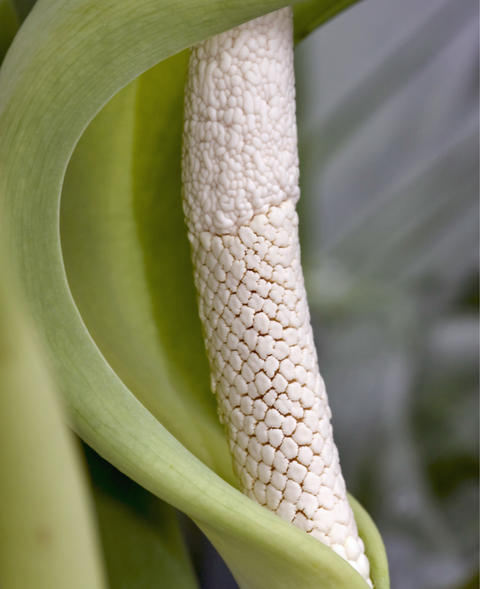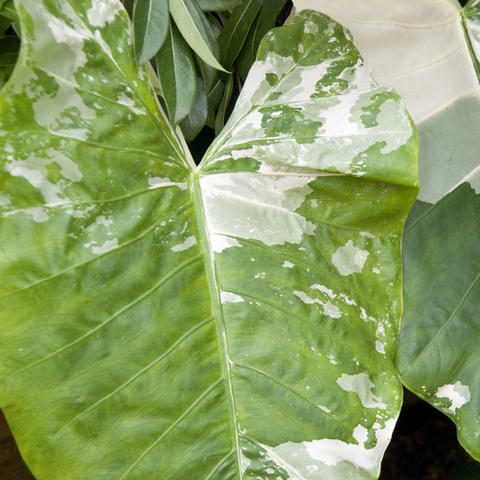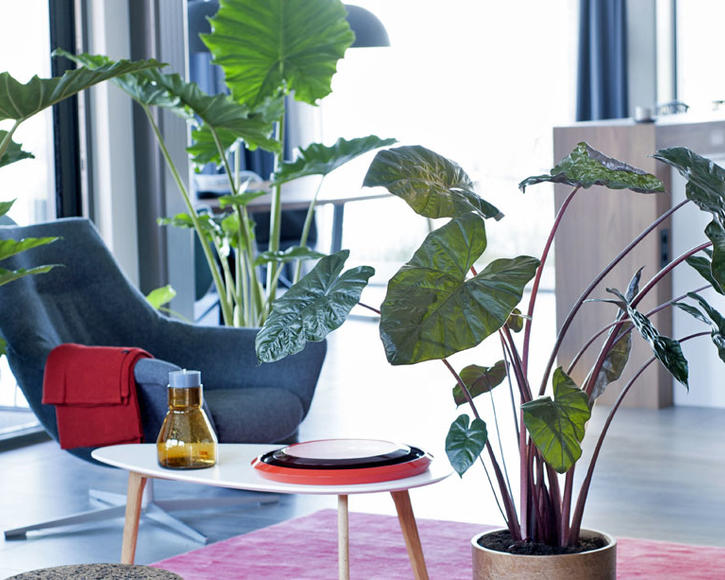Giant Taro
If you have enough space, this houseplant can be used to bring tropical flair to your home all year round. Let us tell you how best to care for giant taro here.
Factsheet
- Growth type
-
- Perennial plant
- Growth height (from)
- from 180 cm to 200 cm
- Growth characteristics
-
- sweeping
- upright
- Flower color
-
- white
- Flower shape
-
- Pistons
- Leaf color
-
- green
- page format
-
- large
- heart-shaped
- oval
- arrow-shaped
- Fruit color
-
- red
- Fruit shape
-
- Berry
- Light
-
- semi-shade to shady
- Soil Moisture
-
- moderately humid to humid
- ph value
-
- weakly acidic
- Nutrient requirements
-
- nutrient-rich
- Humus
-
- rich in humus
- Decorative or utility value
-
- Leaf ornaments
- picturesque growth
- Use
-
- Interior greening
- Planters
- Winter garden
- Warm House
- Garden style
-
- Pot garden
Giant taro (Alocasia macrorrhizos) is a member of the Arum family (Araceae). It naturally grows in the tropical areas of Asia. It’s also called the Giant alocasia, Giant elephant ear and Borneo giant. In its natural habitat, the Giant elephant ear grows to an impressive 26 feet tall, but never exceeds 6.6 feet tall when grown as a houseplant. Nevertheless, this plant is a very popular houseplant here, creating a jungle vibe in the home thanks to its giant green leaves. In its native lands, various varieties of the Giant alocasia have been cultivated so the leaves can be used as a vegetable, while the starchy, potato-like rhizome is an important source of nutrition for the local population. As some Giant taro varieties contain hydrogen cyanide, we wouldn’t advise trying to eat your plant.
The Giant elephant ear’s sturdy rhizomes form long stalks up to 5 feet tall with fan-shaped leaves at the ends. The shrub is very long-lasting and adaptable, and is a fresh green all year round. As already mentioned, the giant taro only grows to around 6.6 feet tall in pots. However, it does need a relatively large amount of space due to its large, spread-out leaves.
The mostly one-tone green leaves of the Giant alocasia really live up to its name, and can reach up to 3.3 feet in diameter. They are oval or cordate/arrow-shaped and may be more or less curled. The leaf veins are clear to see on the blades.
As is standard for arums, the flowers of the Giant taro are long spadix flowers surrounded by a spathe. They are white. They are sadly very rare in houseplants.

After pollination, which takes place through nocturnal insects, bright red berries appear next to one another on the spadex.
Giant elephant ear is perfect as a houseplant at temperate latitudes, bringing tropical flair to large rooms or conservatories. It prefers partially shaded to titleshaded locations and can be kept at room temperature all year round. As it rests during the winter months, temperatures may be lower but should not fall below 59 degrees Fahrenheit. But reduction is not mandatory.

To thrive in containers, the giant taro desperately needs nutrient-rich and humus-rich soil. At the same time, it should be loose and permeable. The ideal pH value is slightly acidic at 5.5.
Big leaves, big thirst: Moist soil is very important for the wellbeing of giant taros kept as houseplants. Keep the soil moist all year round. The plant needs slightly less water in winter, but watering should be gradually increased from around March.
Giant taro is fertilized from the end of March / early April to September. Add a little liquid feed into its water each week. Slow-release fertilizer is not recommended for giant taro. The plant stores nutrients in is thick roots so it will not be distributed evenly.
Giant alocasia grows very quickly in suitable locations, so usually needs a new container at least once a year. The best time to repot is spring, when new shoots are just forming.

There’s no need to prune a Giant taro. Old leaves can simply be removed by hand. A note of caution: only remove them when they have completely wilted. As long as they’re still green or yellow, they contain valuable nutrients that the plant can use.
As long as it isn’t too big and heavy, giant taro may be moved to a or terrace for the summer. It’s important that the location is protected. But the plant has to spend winter inside in temperate to cold zones.

As the Giant taro is still somewhat of a rarity in houseplant terms and is almost exclusively grown as a vegetable in its native lands, there are few varieties. You may find “Variegata” varieties occasionally. This variety’s leaves have a two-tone effect and have a pattern of gray-white spots. The stem is dark purple.
It’s pretty easy to propagate giant taro: simply separate the thick rhizomes. For successful growth, you need a consistently high temperature and very high humidity – as well as patience.
If the giant alocasia is not watered enough in summer, or is dry for an extended period, it may fall foul to spider mites. Although this houseplant likes to be moist, too much water will lead to waterlogging, and sooner or later to root rot, which can even kill the giant alocasia. As bacteria or fungus can be responsible for this disease, treatment with fungicides, for example, is not always successful.

